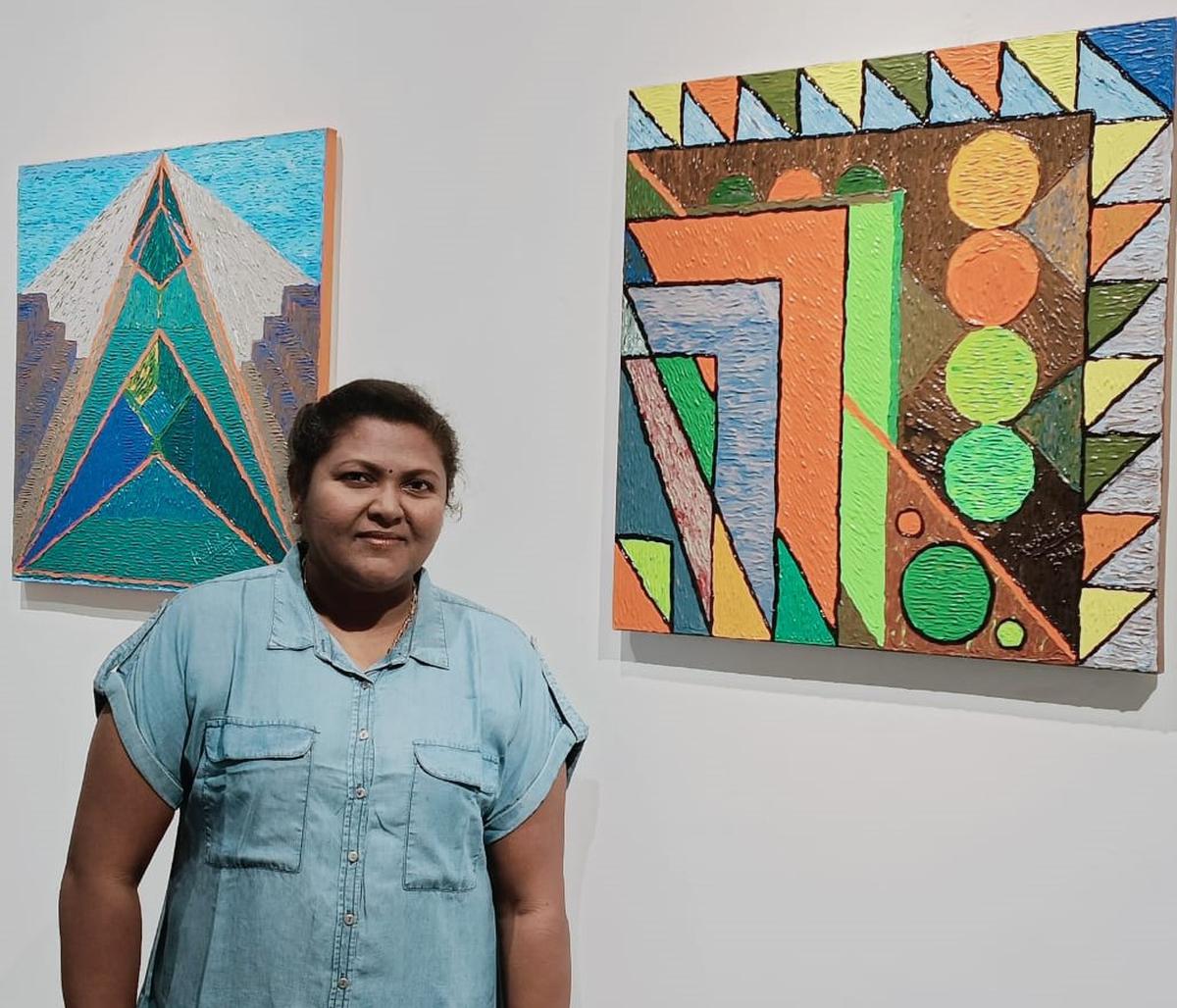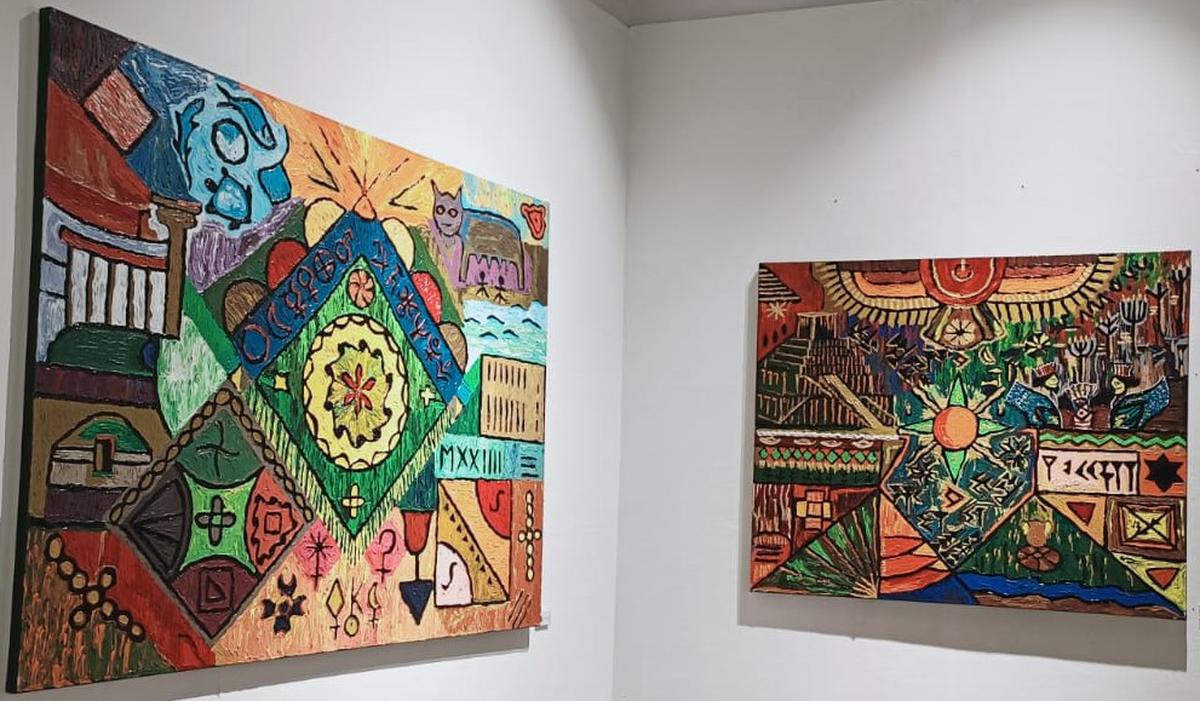Radhika Rani’s exhibition in Thiruvananthapuram is a journey through the history of numerals
[ad_1]
Mathematics, history and art. I B Radhika Rani’s painting exhibition, 1024, is a seamless blend of the three. The artiste has showcased 27 works that explore the evolution of numerals through the ages.
“I have always been fascinated by history. A numeral is a figure, symbol, or letter that stands for a number. It was primarily used to keep accounts than to make calculations. The same idea or concept had different expressions in different civilisations. Also, as I studied mathematics as part of my academics, I often thought about the formation of equations. It felt interesting to go back in time and learn more about all these. The study and research eventually led to certain findings, which I have portrayed in my art,” says Radhika, a civil engineer from Kollam.
The title of the exhibition, 1024, she says, stands for the number 1024, which in the binary system has the number 1 followed by 12 zeroes (10000000000). “I wanted a number that has zero in it since zero is now there in the numerical system of most civilisations,” she explains. The exhibition is primarily about how nine civilisations — Persian, Chinese, Inca, Indian, Greek, Roman, Babylonian, Egyptian and Mayan, used numerals.
There is a blend of concepts, symbols and figures as she uses the acrylic impasto technique to look at how historical developments led to the creation of numerals. The number 1024 is picturised in each painting in different scripts or styles.
Art in numerals
If the Persian has geometric figures and architectural elements such as girih tiles (a set of five tiles used to create geometric patterns in Islamic architecture), the one on Chinese civilisation has popular symbols from the culture (dragon, falcon etc), the concept of magic squares (a grid pattern in which the sum of the numbers in each column, row, and diagonal is 15) and progression, among others.
Can you record facts and figures with knots? Well, the Incas could. The early 15th century AD empire in pre-Columbian America used knotted strings called quipu or khipu to record facts. “Most of the information is numeric. A cluster of knots represented a digit. If it is a zero, there is no knot,” explains Radhika.

Artist Radhika Rani
| Photo Credit:
SPECIAL ARRANGEMENT
Coming to the Indian civilisation, among the various elements represented are Sulba Sutra, which is the geometry related to the construction of altars for the worship of fire, the idea of zero explained by mathematician Brahmagupta, the infinity series, the value of pi, and mathematical elements at Jantar Mantar.
Representation of platonic solids is a highlight of the Greek civilisation. The work also has elements of Minoan (Bronze Age) civilisation, which influenced early Greek civilisation, and the Hellenistic period, the phase when Greek culture spread far and wide. In the case of Rome, Radhika has highlighted the use of Roman numerals based on letters of the Roman alphabet. Zodiac signs, tiling pattern and Solomon’s knot (a decorative motif) among other elements featured in the painting.
From the Babylonian age, she has chosen the use of religious symbols and algorithms while the Egyptian civilisation has been represented through the use of heiroglyphs, in which a specific sign represented a number. An interesting concept is the hieroglyphic version of the Eye of Horus, which is based on the mythical conflict between the god Horus and his opponent Set, who tore out the former’s eyes. Another god, Thoth, put the pieces back and healed the eye. “Ancient Egyptians used the pieces of Horus’ eye to describe fractions,” Radhika says.
Mayans, meanwhile, seems to have had a base-20 system, probably by counting the fingers and the toes. “If Egypt had hieroglyphs, Mayan used face glyphs. They have also recorded planetary movements,” she adds.

Paintings by Radhika Rani from her ‘1024’ exhibition
| Photo Credit:
SPECIAL ARRANGEMENT
An interesting element of the exhibition is an interactive art based on Ka Ta Pa Ya Di, the numeral system that used letters of the alphabet (Sanskrit consonants) to represent numbers. This ancient practice is believed to have been developed in Kerala. Radhika has displayed details about the system so that visitors can try their hand at using the system.
There are exhibits on general mathematical concepts such as the Fibonacci series in which each number is the sum of the two preceding ones. Besides mathematics, the sequence is used to describe certain shapes that we see around us, which is called logarithmic spirals. It is found in sunflowers, nautilus shells, and petals of different flowers. Radhika has beautifully captured this feature of the sequence.
Works based on Bhootasankhya system or recording numbers using common nouns (eg: one for earth, two for eye, four for Vedas etc), value of pi, trigonometry, triangles, permutations and combinations in KaTaPaYaDi, representation of planets and eclipses… have also been respresented in her art.
The artist has also put up a few of her poems, again related to numerals.
The exhibition is on at Amuseum art gallery, near Althara junction, Vellayambalam, and ends on February 19.
[ad_2]
Source link